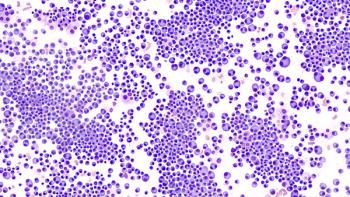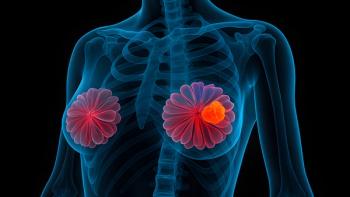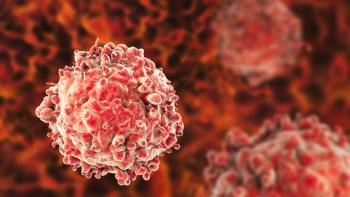
Doxepin Rinse Relieves Pain in Patients With Radiation-Related Oral Mucositis
Doxepin rinse may prove to be a viable option for the relief of pain associated with oral mucositis in patients with head and neck cancers
Doxepin rinse may prove to be a viable option for the relief of pain associated with oral mucositis in patients with head and neck cancers, according to findings of a phase III trial published online ahead of print April 14 in the Journal of Clinical Oncology.
Painful oral mucositis (OM) occurs in the majority of head and neck cancer patients treated with radiation, regardless of whether they receive chemotherapy. OM-triggered pain can lead to malnutrition and dehydration; when severe, it can result in an increased risk of infection, as well as dose limitations and treatment interruptions.
This randomized, double-blind, placebo-controlled trial, conducted under the auspices of the Alliance for Clinical Trials in Oncology cooperative group, enrolled 155 patients who were being treated at 26 cancer centers across the country between December 2010 and May 2012. To be eligible, patients were undergoing radiotherapy to a minimum planned dose of 50 Gy and experiencing OM-related pain ≥4 on a 0 to 10 scale.
Participants were randomized 1:1 to receive either doxepin (25 mg diluted to 5 mL with 2.5 mL of sterile or distilled water) on day 1, then crossing over to a placebo of a sugar-free flavored syrup on a subsequent day (arm A), or placebo on the first day followed by the doxepin preparation (arm B). Patients in both arms were instructed to swish the solution in their mouth for 1 minute, gargle, and expectorate.
The study’s primary endpoint was a reduction in pain as measured by the pain scale’s area under the curve (AUC), using assessments based on the Oral Mucositis Daily and Weekly Questionnaires— Head and Neck Cancer, administered at baseline and at 5, 15, 30, 60, 120, and 240 minutes for each treatment arm. Patients were allowed to leave after the first hour, instructed to complete the questionnaires at 2- and 4-hour intervals, and received telephone reminders.
Researchers reported that the AUC for the mean reduction in mouth and throat pain was significantly greater with doxepin than placebo, —9.1 and —4.7, respectively; P <.001. Intrapatient changes of +4.1 for arm A and —2.8 for arm B were determined through crossover analyses, equivalent to a treatment difference of —3.5 (95% CI, —5.1 to —1.8; P <.001), for doxepin versus placebo.
As secondary outcomes, researchers also assessed any stinging or burning, unpleasant taste, and/or drowsiness resulting from the rinse, as well as whether additional analgesia was required 2 and 4 hours after administration.
Adverse effects of doxepin were typically mild and consistent with those identified in previous phase I/II studies. The AUC for stinging and burning was significantly higher with doxepin, being highest 5 minutes after rinsing. The sensations were reduced, but remained statistically significant, over the 4-hour postrinse assessment.
Taste also was ranked using AUC on a 0 (acceptable) to 10 (terrible) scale; patients preferred the placebo rinse (5.5) to the doxepin rinse (7.7). After 5 minutes, however, both were deemed acceptable: doxepin rinse (2.9), placebo rinse (1.6)
No significant differences were reported in the use of additional analgesics following use of the rinse versus placebo. Drowsiness was associated more with doxepin, a known adverse effect of the agent; however, differences with placebo did not reach statistical significance until assessment at 2 hours (3.9 for doxepin vs 2.8 for placebo; P = .02), based on a scale of 0 (no drowsiness) to 10 (extreme drowsiness resulting in sleep). The researchers noted that some patients deemed the rinse’s sedative effect beneficial as a sleep aid.
Notably, the researchers reported that 63% of patients (n = 81) chose to continue using the doxepin rinse at the conclusion of the trial, with more patients in arm A indicating a desire to continue treatment than those in arm B. Of those who continued the treatment, 14 (17%) subsequently stopped, citing burning discomfort and drowsiness most often.
Numerous studies over the years have examined the efficacy of other rinse agents such as chlorhexidine, “magic mouthwash,” and phenytoin to relieve OM. The study reported here, noted corresponding author Robert C. Miller, MD, et al, represents “the largest placebo-controlled trial to date specifically testing the efficacy of a rinse agent in controlling established mucositis pain and the only such trial with positive results.” The authors recommended further study to fully evaluate the rinse’s efficacy in treating OM pain in this setting.
Nurse Perspective
Colleen M. O’Leary, RN, MSN, AOCNS
Clinical Nurse Specialist
The James Cancer HospitalThe Ohio State University Comprehensive Cancer CenterColumbus, OH
The incidence of oral mucositis (OM) in patients with head and neck cancer receiving radiotherapy is between 80% and 100%. If the patients are receiving concomitant chemotherapy, it is virtually guaranteed they will experience OM. As the authors point out, this can lead to several untoward results, including a change in the amount, duration, or frequency of treatment. In addition, patients with head and neck cancer are usually already at risk for malnutrition due to their disease, surgical interventions, or lifestyle prior to starting radiotherapy. The development of severe OM increases this risk exponentially.
Although several agents and treatments have shown promise with the management of OM, very few have truly made a consistent dent in this problem for patients. The use of doxepin may be something that can be used to finally get a handle on this for patients. However, as the authors note, more research is needed.
It is important to focus on the unpleasant side effects of this rinse and work to eliminate them. As with several other agents that have been studied, the taste of this rinse was not as pleasant as the placebo. Where a patient might use this product during the study, in the long run, if it is not pleasant tasting, they are more inclined to stop using it and return to other agents or therapies such as opioids for pain control.
In addition, the study indicated that this rinse caused stinging, burning, and taste changes. As with the unpleasant taste, if a patient has to endure increased pain temporarily in order to get some relief, they may use it, but it would serve our patients better if we could find something to decrease pain that doesn’t cause pain itself. And, if this agent causes changes in taste, then perhaps the taste of the few foods that our patients can eat and enjoy will be altered.
Finally, doxepin was shown to cause more drowsiness than placebo, which again works against known therapies for side effects, such as pain and fatigue—namely moderate aerobic exercise. We know it is better for our patients to be at least moderately active for a variety of reasons, and if we now are giving them something that decreases their ability to be active, the efforts basically work against each other
An interesting finding was that, even given the side effects of doxepin, more people in the study said they would want to continue with the rinse than with placebo. This perhaps warrants further study looking at the reasons behind this, and if the desire to continue the treatment will be long lasting.
OM continues to be a devastating toxicity of both chemotherapy and radiotherapy for patients with head and neck cancer. It is imperative that research continue to find effective long-lasting treatment. Rinses such as doxepin are promising. Low-level laser therapy is another treatment that is being used with very good results and few side effects, but it is not generally available in all areas due to the cost of the equipment and need for specially trained clinicians. However, this is a treatment where nurses can step up and take the reins.
It is clear that the area of prevention and management of OM is vital to improving the quality of life of patients with head and neck cancer as well as other cancers. Continued efforts to develop and refine treatments can only benefit our patients.
Newsletter
Knowledge is power. Don’t miss the most recent breakthroughs in cancer care.
















































































